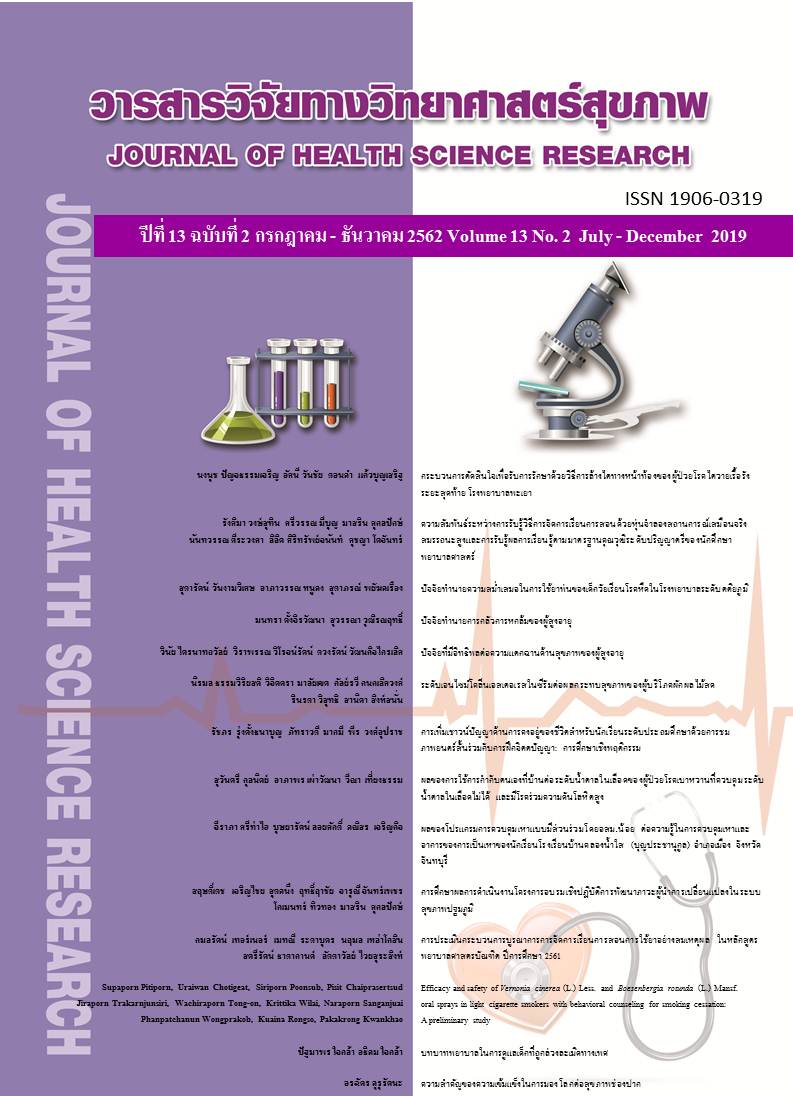ความสำคัญของความเข้มแข็งในการมองโลกต่อสุขภาพช่องปาก
Main Article Content
บทคัดย่อ
ความเข้มแข็งในการมองโลกเป็นแนวคิดหลักของรูปแบบจำลองสุขภาพซาลูโตเจนิก (Salutogenic model) เป็นความสามารถของบุคคลในการใช้ทรัพยากร ที่มีอยู่ในการเอาชนะอุปสรรค และจัดการกับความเครียดโดยที่บุคคลนั้นยังคงมีสุขภาพและคุณภาพชีวิตที่ดี มีคุณลักษณะ 3 ประการคือ ความเข้าใจ ความสามารถจัดการได้ และการเห็นคุณค่าความหมาย ดังนั้นบุคคลที่มีความเข้มแข็งในการมองโลกสูงจะสามารถจัดการกับปัญหาอุปสรรคที่เกิดขึ้นในชีวิตได้ดี จึงมีโอกาสไปรับบริการทันตกรรมเป็นประจำ และมีแนวโน้มที่จะมีสุขภาพช่องปากที่ดี เช่น มีสภาวะปริทันต์ที่ดี และเป็นโรคฟันผุน้อย บทความนี้นำเสนอผลการศึกษาความเข้มแข็งในการมองโลกและสุขภาพช่องปาก เพื่อหาข้อสรุปว่าสามารถนำการพัฒนาความเข้มแข็งในการมองโลกมาเป็นทางเลือกในการสร้างเสริมสุขภาพช่องปากหรือไม่ ผลการวิจัยที่ผ่านมา พบว่าผู้ที่มีความเข้มแข็งในการมองโลกสูงมีพฤติกรรมที่เอื้อต่อการมีสุขภาพช่องปากที่ดี เช่น การแปรงฟันถี่ ไม่รับประทานอาหารระหว่างมื้อ และเข้ารับบริการทันตกรรมอย่างสม่ำเสมอ เป็นต้น จากข้อสรุปที่ได้ทำให้สามารถใช้การพัฒนาความเข้มแข็งในการมองโลกเป็นทางเลือกเสริมในการสร้างเสริมสุขภาพช่องปาก
Downloads
Article Details
บทความที่ได้รับการตีพิมพ์เป็นลิขสิทธิ์ของวิทยาลัยพยาบาลบรมราชชนนี จังหวัดนนทบุรี
ข้อความที่ปรากฏในบทความแต่ละเรื่องในวารสารวิชาการเล่มนี้เป็นความคิดเห็นส่วนตัวของผู้เขียนแต่ละท่านไม่เกี่ยวข้องกับวิทยาลัยพยาบาลบรมราชชนนี จังหวัดนนทบุรี และคณาจารย์ท่านอื่น ในวิทยาลัยฯ แต่อย่างใด ความรับผิดชอบองค์ประกอบทั้งหมดของบทความแต่ละเรื่องเป็นของผู้เขียนแต่ละท่าน หากมีความผิดพลาดใด ๆ ผู้เขียนแต่ละท่านจะรับผิดชอบบทความของตนเองแต่ผู้เดียว
เอกสารอ้างอิง
2. Werner H, Hakeberg M, Dahlström L, Eriksson M, Sjögren P, Strandell A, et al. Psychological interventions for poor oral health: a systematic review. J Dent Res. 2016;95:506-14.
3. Antonovsky A. Unraveling the mystery of health: how people manage stress and stay well. 1st ed San Francisco, CA: Jossey-Bass; 1987.
4. Eriksson M, Lindstrom B. Antonovsky's sense of coherence scale and its relation with quality of life: A systematic review. J Epidemiol Community Health. 2007;61:938–44.
5. Eriksson M, Lindström B. Antonovsky's sense of coherence scale and the relation with health: a systematic review. J Epidemiol Community Health. 2006;60:376–81.
6. Lindmark U, Hakeberg M, Hugoson A. Sense of coherence and its relationship with oral health-related behaviour and knowledge of and attitudes towards oral health. Community Dent Oral Epidemiol. 2011;39:542-53.
7. Bernabé E, Kivimäki M, Tsakos G, Suominen-Taipale AL, Nordblad A, Savolainen J, et al. The relationship among sense of coherence, socio-economic status, and oral health-related behaviours among Finnish dentate adults. Eur J Oral Sci. 2009; 117:413–18.
8. Dorri M, Sheiham A, Watt RG. Modelling the factors influencing general and oral hygiene behaviours in adolescents. Int J Paediatr Dent. 2010;20:261–69.
9. Peker K, Bermek G, Uysal O. Factors related to sense of coherence among dental students at Istanbul University. J Dent Educ. 2012;76: 774–82.
10. Elyasi M, Abreu LG, Badri P, Saltaji H, Flores-Mir C, Amin M. Impact of sense of coherence on oral health behaviors: a systematic review. Plos One. 2015;10:1-16.
11. Qiu RM, Wong MC, Lo EC, Lin HC. Relationship between children's oral health-related behaviors and their caregiver's sense of coherence. BMC Public Health. 2013;13: 1-7.
12. da Silva AN, Mendonca MH, Vettore MV. The association between low-socioeconomic status mother's sense of coherence and their child's utilization of dental care. Community Dent Oral Epidemiol. 2011;39:115–26.
13. Bernabe E, Watt RG, Sheiham A, Suominen-Taipale AL, Uutela A, Vehkalahti MM, et al. Sense of coherence and oral health in dentate adults: findings from the Finnish Health 2000 survey. J Clin Periodontol. 2010;37:981-7.
14. Gururatana O. The effects of sense of coherence intervention on Thai children plaque level and gingival health in Chonburi province, Thailand. Journal of Health Science Research. 2018;12 Suppl :1-11. (in Thai).
15. Reddy KS, Doshi D, Kulkarni S, Reddy BS, Reddy MP. Correlation of sense of coherence with oral health behaviors, socioeconomic status and periodontal status. J Indian Soc Periodontol. 2016;20:453-9.
16. Kanhai J, Harrison VE, Suominen AL, Knuuttila M, Uutela A, Bernabé E. Sense of coherence and incidence of periodontal disease in adults. J Clin Periodontol. 2014;41:760-5.
17. Savage A, Eaton KA, Moles DR, Needleman I. A systematic review of definitions of periodontitis and methods that have been used to identify this disease. J Clin Periodontol. 2009;36:458–67.
18. Viswanath D, Krishna AV. Correlation between dental anxiety, Sense of Coherence (SOC) and dental caries in school children from Bangalore North: A cross-sectional study. J Indian Soc Pedod Prev Dent. 2015; 33:15–8.
19. Tomazoni F, Vettore MV, Mendes FM, Ardenghi TM. The association between sense of coherence and dental caries in low social status schoolchildren. Caries Res. 2019;53:314–21.
20. Lyra MC, Cruz M, Menezes V, Heimer MV. Association between Sense of Coherence and dental caries experience in adolescents. Braz Res Pediatr Dent Integrated Clin. 2015;15:235–41.
21. Lage CF, Fulgencio LB, Corrêa-Faria P, Serra-Negra JM, Paiva SM, Pordeus IA. Association between dental caries experience and sense of coherence among adolescents and mothers. Int J Paediatr Dent. 2017;27:412-9.
22. Marmot M, Wilkinson RG, editors. Social determinants of health. 2nd ed. Oxford: Oxford University Press; 2005.
23. Lindström B, Eriksson M. Salutogenesis. J Epidemiol Community Health. 2015;59:440–2.
24. da Silva AN, Vettore MV. Sense of coherence modifies the association between untreated dental caries and dental pain in low-social status women. Community Dent Health. 2016;33:54-9.
25. Nammontri O, Robinsion PG, Baker SR. Enhancing oral health via sense of coherence: A cluster-randomized trial. J Dent Res. 2013; 92:26-31.


